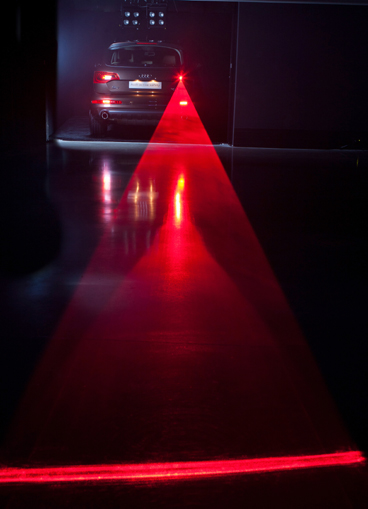Audi has revealed a glimpse into how its engineers are looking to develop light technology on future models, including the use of lasers, wipe-action indictors and speed-sensitive swarms of organic LEDs.
Audi’s lighting engineers are looking to further push boundaries by developing systems that will be capable of reacting more intelligently to environmental conditions and surrounding road users.
The most dramatically different of these, at first glance at least, is the OLED swarm. This transforms the rear of the car into a large, continuous illuminated surface on which a large number of small points of light fluctuate like a swarm of bees or a shoal of fish.
Movements of the red dots take their orientation from movements of the vehicle, so when a right turn is made, for example, they flow to the right, and when the car is braked they flow rapidly forwards. The faster the car is driven, the faster the dots move, helping following drivers to gauge its actions.
The swarm is comprised of ‘Organic Light Emitting Diodes’ (OLEDs), which differ from today’s LEDs in that they are formed from an organic material rather than semiconductor crystals.
In its basic form the organic material is a paste that can be applied at a depth of just a fe thousandths of a millimetre to a flat surface. When an electrical voltage is applied, the molecules in the paste emit photons and the surface lights up.
OLEDs have potential for many other applications, as proven by the recent A2 concept, which features a thin band of OLED light connecting its headlights with its tail lights.
When the A2 concept is in standby-mode, the band is coloured black, but when the key-holder approaches, it lights up blue and intensifies illumination of the door handles.
When the concept is in motion it shines bright orange, and pulses on the corresponding side when the indicator is activated. When braking, a red pulse of light runs along the flank as a warning for other road users.
Wipe-action indicators
Audi is also developing advanced indicator lights that appear to perform a wiping movement from the inside outwards, making them more noticeable than the latest LED indicator systems.
Matrix beam headlights obtain the information they need from a camera, from the navigation system and from additional sensors. If the camera detects other vehicles or the lights of a built-up area ahead, the headlights fade out the appropriate sector of the high-beam headlight matrix.
They are already aware of the topography of the road and can also vary the illumination they provide according to weather conditions such as rain or fog.
In the more distant future the matrix beam lights will be capable of picking out important objects in the driver’s field of view and either illuminating them more directly, if the object is a person, animal or road sign, or diverting their light pool around them if the object is a vehicle either travelling ahead or oncoming.
Lights requiring even greater intensity than headlamps may reap the benefit of advanced laser technology in future Audi models. Engineers are developing a rear fog light that uses a laser diode to project a bright, clear red line onto the road surface if visibility is moderately good. The width of this line depends on how far behind the following car is travelling - if it is 30 metres or more behind the line is approximately as wide as the car.
Laser beam warning triangle
In fog or spray, the laser beam strikes the water droplets in the air and makes them visible; the laser rear fog light then takes the form of a large warning triangle.




















Login to comment
Comments
No comments have been made yet.